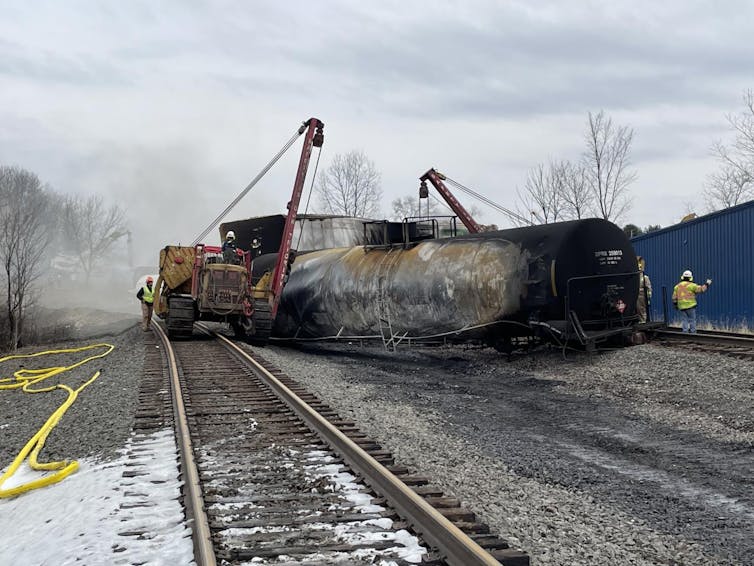Fewer than two months soon after teach automobiles filled with dangerous chemical compounds derailed in Ohio and caught hearth, a truck carrying nitric acid crashed on a significant freeway exterior Tucson, Arizona, killing the driver and releasing toxic substances into the air.
The Arizona hazmat catastrophe shut down Interstate 10, a significant cross-region freeway, and pressured evacuations in encompassing neighborhoods.
Browse Additional: What we know about the chemicals aboard the teach that derailed in Ohio
But the highway crash didn’t attract nationwide awareness the way the train derailment did, or induce a flood of calls for additional trucking regulation like the U.S. is looking at for train regulation. Truck crashes are likely to be neighborhood and a lot less dramatic than a pile of derailed teach vehicles on hearth, even if they are deadlier.
In actuality, federal facts displays that rail has experienced considerably fewer incidents, fatalities and problems when relocating dangerous supplies in the U.S. than vans.
Trucks carry far more hazmat and more threat
At one time, rail and h2o had been the only options for transporting substances and other likely hazardous components. The emergence of the vehicle and subsequent construction of the interstate freeway technique adjusted that, and dangerous supplies shipments by street steadily amplified.
Today, vans have the premier percentage of harmful components delivered in the U.S. – about 2 times as substantially as trains when calculated in ton-miles, in accordance to the Office of Transportation’s Bureau of Transportation Statistics’ most current info, for 2017. A ton-mile is a single ton shipped for one particular mile.
Even though truck incidents involving dangerous components really don’t search as spectacular as coach derailments and are not as greatly included by information media, federal details exhibits they depict far more fatalities and assets destruction, and there are countless numbers much more of them just about every year.
Truck-linked harmful elements incidents brought about in excess of 16 instances far more fatalities from 1975 to 2021 – 380 for truck, when compared with 23 for rail, according to the Bureau of Transportation Statistics. The change is additional pronounced in the very last decade, when U.S. rail transportation of hazardous supplies caused zero fatalities and truck incidents were responsible for 83.
Trucks have also triggered virtually 3 situations as a great deal property problems as rail incidents since 2000. That could possibly seem to be astonishing considering that derailments can include several automobiles with harmful supplies. But most rail gatherings get area in remote places, restricting their human impression, when vans vacation on highways with other motorists around and usually in active urban places.
Wherever do we go from right here?
I review rail systems and regulation, and I have adopted the escalating charges to the industry to comply with tightening regulatory rules.
Delivery hazardous resources in the U.S. has been regulated for about 150 decades. A fatal explosion in San Francisco in 1866 involving a just-arrived cargo of nitroglycerin, utilised for blasting rock, led to the initially federal laws regulating shipping and delivery explosives and flammable components.
The Sept. 11, 2001, terrorist attacks spurred a large enlargement of regulation about motion of hazardous supplies. A lot of cities now have hazardous materials routes for trucks that circumvent metropolis facilities to decrease the likely hazard to large-populace places.
With the Ohio coach derailment now generating national news, lawmakers are concentrating on laws specially for rail.
Ohio’s governor needs rail firms to be needed to notify states of all dangerous shipments. This knee-jerk response to a significant occasion would appear to be a liable demand with somewhat minimal fees, but it would have no effects in anyway on prevention of hazmat functions.
Look at: Release of poisonous chemical substances from educate derailment in Ohio prompts broader basic safety fears
Activists are contacting for more high priced investments, like requirements for warmth sensors on teach bearings, which appeared to have been involved in the Ohio derailment, and the restoration of a rule necessitating state-of-the-art braking devices for trains carrying dangerous materials. Both of those would increase the charge of rail shipping and could wind up putting much more hazardous supplies shipments on U.S. streets. The Trump administration repealed the braking procedure necessity in 2017, arguing that the fees outweighed the benefits.
U.S. Transportation Secretary Pete Buttigieg, talking with reporters, discussed hunting into new guidelines for advanced braking devices, bigger fines and encouraging rail corporations to pace up their section-in of a lot more puncture-resistant tank cars and trucks.
Rail is continue to far more economical and improved for the atmosphere than vehicles for for a longer period distances, but with at any time-raising polices, rail transportation can be economically and logistically discouraged – chasing much more traffic to far additional unsafe roadways.
If the worry is the public’s exposure to hazardous components, regulation on road-based dangerous products transportation really should increase as nicely.
This write-up is republished from The Conversation underneath a Inventive Commons license. Browse the original post.
![]()











More Stories
Injured in a Truck Accident? Trust Our Roseville Attorneys for Justice!
Questions to Ponder Before Hiring a Truck Accident Lawyer
One Dead After Fuel Tanker Explosion on Connecticut I-95 Bridge